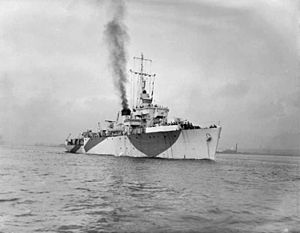Our website is made possible by displaying online advertisements to our visitors.
Please consider supporting us by disabling your ad blocker.
HMS Vestal (J215)

| |
| History | |
|---|---|
| Name | HMS Vestal |
| Builder | Harland and Wolff, Belfast[1] |
| Yard number | 1147[2] |
| Laid down | 11 January 1943 |
| Launched | 19 June 1943 |
| Completed | 10 September 1943[2] |
| Commissioned | 11 February 1944 |
| Identification | Pennant number: J299 |
| Fate | Hit by a Japanese kamikaze pilot on 26 July 1945 and subsequently scuttled |
| Badge | A sacred flame which was brought to Rome by Aeneas, and was then tended to by Vesta, Goddess of the Hearth. The patch is blue; with a gold altar with a flame.[3] |
| General characteristics | |
| Class and type | Algerine-class minesweeper |
| Length | 255 ft (78 m) |
| Beam | 35.5 ft (10.8 m) |
| Draft | 3.50 |
| Propulsion | Steam Turbine[4] |
| Speed | 16.5 knots (30.6 km/h) |
| Crew | 104–135 |
| Armament |
|
HMS Vestal[6] was a turbine-powered Algerine-class minesweeper of the Royal Navy. She was launched in 1943 and saw service in the Pacific War against the Empire of Japan. She was critically damaged by Japanese kamikaze aircraft in 1945 and was subsequently scuttled in waters close to Thailand.
Vestal was the only British ship to be sunk by kamikaze attack[7] and the last Royal Navy ship to be lost in the Second World War.[8] She was sunk whilst partaking in Operation Livery. Vestal was commanded by Lt. Charles William Porter, DSC, from 26 July 1943 until 26 July 1945, when the ship was sunk.[9] Her engine was provided by Paxman.[10]
- ^ "HMS Vestal-World Naval Ships Directory". World Naval Ships. Retrieved 24 June 2013.
- ^ a b McCluskie, Tom (2013). The Rise and Fall of Harland and Wolff. Stroud: The History Press. p. 151. ISBN 9780752488615.
- ^ "The 110 Ships, Their Fate & Their Badges RN(6)". Minesweepers.org. Retrieved 24 June 2013.
- ^ "HMS Vestal (J-215)". Wreck Site. Retrieved 22 June 2013.
- ^ "HMS Vestal (J215)". Warships of World War II. Archived from the original on 24 June 2013. Retrieved 22 June 2013.
- ^ "HMS Vestal (FL 21022)". Imperial War Museum. Retrieved 22 June 2013.
- ^ "Saundersfoot War Memorial". WW1.Wales. Retrieved 30 January 2023.
- ^ Cite error: The named reference
HMS Vestal backgroundwas invoked but never defined (see the help page). - ^ "HMS Vestal (J 215) of the Royal Navy". uboat.net. Retrieved 22 June 2013.
- ^ "Paxman and the Royal Navy-Surface Ships". Paxman History. Archived from the original on 27 May 2011. Retrieved 24 June 2013.
Previous Page Next Page


